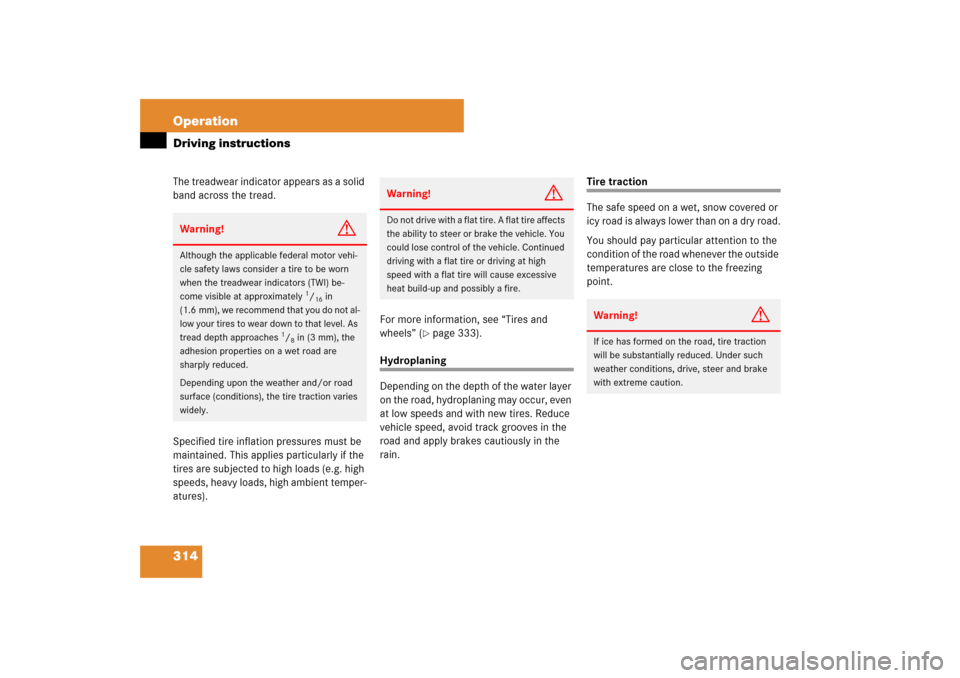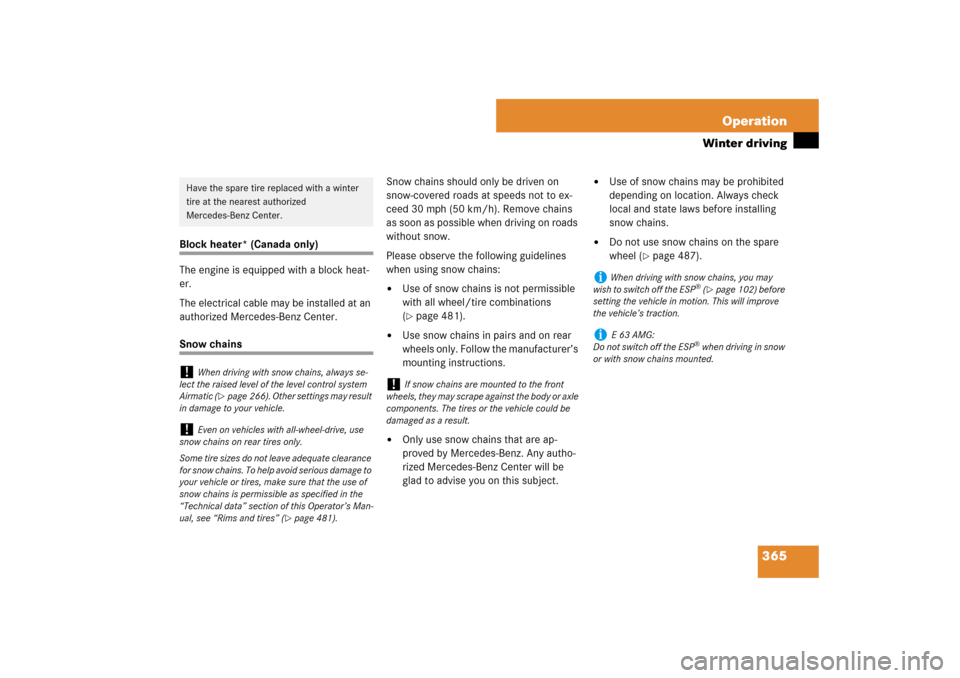Page 315 of 522

314 OperationDriving instructionsThe treadwear indicator appears as a solid
band across the tread.
Specified tire inflation pressures must be
maintained. This applies particularly if the
tires are subjected to high loads (e.g. high
speeds, heavy loads, high ambient temper-
atures).For more information, see “Tires and
wheels” (
�page 333).
Hydroplaning
Depending on the depth of the water layer
on the road, hydroplaning may occur, even
at low speeds and with new tires. Reduce
vehicle speed, avoid track grooves in the
road and apply brakes cautiously in the
rain.
Tire traction
The safe speed on a wet, snow covered or
icy road is always lower than on a dry road.
You should pay particular attention to the
condition of the road whenever the outside
temperatures are close to the freezing
point.
Warning!
G
Although the applicable federal motor vehi-
cle safety laws consider a tire to be worn
when the treadwear indicators (TWI) be-
come visible at approximately
1/16in
(1.6 mm), we recommend that you do not al-
low your tires to wear down to that level. As
tread depth approaches
1/8in (3 mm), the
adhesion properties on a wet road are
sharply reduced.
Depending upon the weather and/or road
surface (conditions), the tire traction varies
widely.
Warning!
G
Do not drive with a flat tire. A flat tire affects
the ability to steer or brake the vehicle. You
could lose control of the vehicle. Continued
driving with a flat tire or driving at high
speed with a flat tire will cause excessive
heat build-up and possibly a fire.
Warning!
G
If ice has formed on the road, tire traction
will be substantially reduced. Under such
weather conditions, drive, steer and brake
with extreme caution.
Page 359 of 522

358 OperationTires and wheelsQuality grades can be found, where appli-
cable, on the tire sidewall between tread
shoulder and maximum section width. For
example:
All passenger car tires must conform to
federal safety requirements in addition to
these grades.
Treadwear
The treadwear grade is a comparative rat-
ing based on the wear rate of the tire when
tested under controlled conditions on a
specified government test course. For ex-
ample, a tire graded 150 would wear one
and one-half (1
1/2) times as well on the
government course as a tire graded 100.The relative performance of tires depends
upon the actual conditions of their use,
however, and may depart significantly
from the norm due to variations in driving
habits, service practices and differences in
road characteristics and climate.
Traction
The traction grades, from highest to low-
est, are AA, A, B, and C. Those grades rep-
resent the tire’s ability to stop on wet
pavement as measured under controlled
conditions on specified government test
surfaces of asphalt and concrete. A tire
marked C may have poor traction perfor-
mance.Temperature
The temperature grades are A (the high-
est), B, and C, representing the tire’s resis-
tance to the generation of heat and its
ability to dissipate heat when tested under
controlled conditions on a specified indoor
laboratory test wheel. Sustained high tem-
perature can cause the material of the tire
to degenerate and reduce tire life, and ex-
cessive temperature can lead to sudden
tire failure. The grade C corresponds to a
level of performance which all passenger
car tires must meet under the Federal Mo-
tor Vehicle Safety Standard No. 109.
Grades B and A represent higher levels of
performance on the laboratory test wheel
than the minimum required by law.
Treadwear
Traction
Temperature
200
AA
A
Warning!
G
The traction grade assigned to this tire is
based on straight-ahead braking traction
tests, and does not include acceleration,
cornering, hydroplaning, or peak traction
characteristics.
Page 366 of 522

365 Operation
Winter driving
Block heater* (Canada only)
The engine is equipped with a block heat-
er.
The electrical cable may be installed at an
authorized Mercedes-Benz Center.Snow chainsSnow chains should only be driven on
snow-covered roads at speeds not to ex-
ceed 30 mph (50 km/h). Remove chains
as soon as possible when driving on roads
without snow.
Please observe the following guidelines
when using snow chains:
�
Use of snow chains is not permissible
with all wheel/tire combinations
(�page 481).
�
Use snow chains in pairs and on rear
wheels only. Follow the manufacturer’s
mounting instructions.
�
Only use snow chains that are ap-
proved by Mercedes-Benz. Any autho-
rized Mercedes-Benz Center will be
glad to advise you on this subject.
�
Use of snow chains may be prohibited
depending on location. Always check
local and state laws before installing
snow chains.
�
Do not use snow chains on the spare
wheel (
�page 487).
Have the spare tire replaced with a winter
tire at the nearest authorized
Mercedes-Benz Center.!
When driving with snow chains, always se-
lect the raised level of the level control system
Airmatic (
�page 266). Other settings may result
in damage to your vehicle.
!
Even on vehicles with all-wheel-drive, use
snow chains on rear tires only.
Some tire sizes do not leave adequate clearance
for snow chains. To help avoid serious damage to
your vehicle or tires, make sure that the use of
snow chains is permissible as specified in the
“Technical data” section of this Operator’s Man-
ual, see “Rims and tires” (
�page 481).
!
If snow chains are mounted to the front
wheels, they may scrape against the body or axle
components. The tires or the vehicle could be
damaged as a result.
i
When driving with snow chains, you may
wish to switch off the ESP
® (�page 102) before
setting the vehicle in motion. This will improve
the vehicle’s traction.
i
E63AMG:
Do not switch off the ESP
® when driving in snow
or with snow chains mounted.
Page 383 of 522
382 Practical hintsWhat to do if …Problem
Possible cause/consequence
Suggested solution
v
The yellow ESP
® warning
lamp flashes while driving.
The ESP
® or traction control has come into
operation because of detected traction loss
in at least one tire.
The cruise control and the Distronic* system
are deactivated.
�
When driving off, apply as little throttle as
possible.
�
While driving, ease up on the accelerator.
�
Adapt your speed and driving to the pre-
vailing road and weather conditions.
�
Do not deactivate the ESP
®.
Exceptions: (
�page 104).
Failure to follow these instructions increases
the risk of an accident.
Page 506 of 522

505 Index
Drinking and driving 309
Driving
Abroad 317
Hydroplaning 314
In winter 316
Instructions 49, 309
Problems 60
Safety systems 97
Through standing water 317
With Distronic* 262
Driving safety systems
4MATIC 105
ABS 97
BAS 99
EBP 100
ESP
®
100
Four wheel electronic traction system
with ESP
®
105
Driving systems
Airmatic DC (Dual Control) 265
Cruise control 249
Distronic* 252
Parktronic system* 269
Driving tips 188
Accelerator position 188
Kickdown 188E
Easy-entry/exit feature 46, 178
EBP 100
Electrical fuses see Fuses
Electrical system, Technical data 488
Electronic Stability Program see
ESP
®
100
Emergency calls
Tele Aid calls 295
Emergency operation (Limp-Home
Mode) 197
Emergency operations 437
Gear selector lever, Unlocking 438
Locking/unlocking the vehicle 436
Remote door unlock 300
Tilt/sliding sunroof or tilt/sliding pan-
el*, Manual operation 439
Trunk lid, Releasing from inside 125
Trunk lid, Unlocking 437
Emergency Tensioning Device see ETDEmergency, In case of
Battery, Jump starting 464
First aid kit 432
Flat tire, changing 452
Fuses
Hazard warning flasher 144
Instrument cluster, Indicator
lamps 380, 381, 382, 383, 384,
385, 386, 387, 390, 391
Roadside Assistance 12
Towing the vehicle 466
Emission control 319
Information label 477
Vacuum line routing diagram
label 477
Emission control system warranties 10